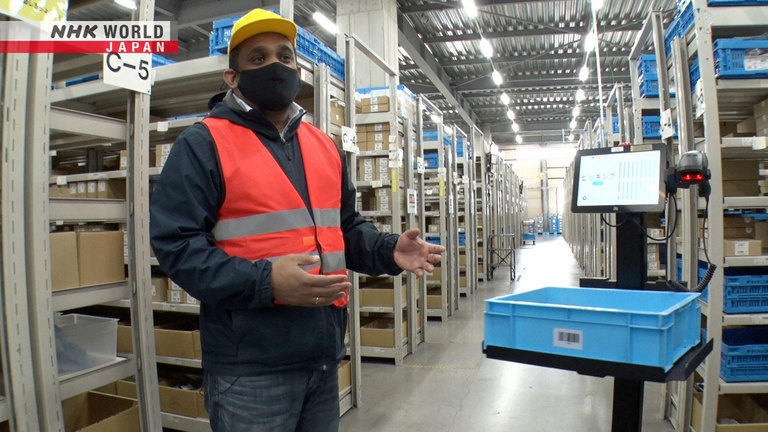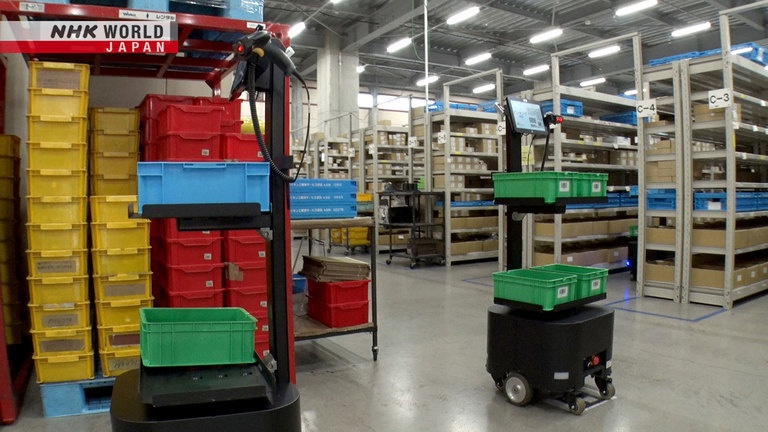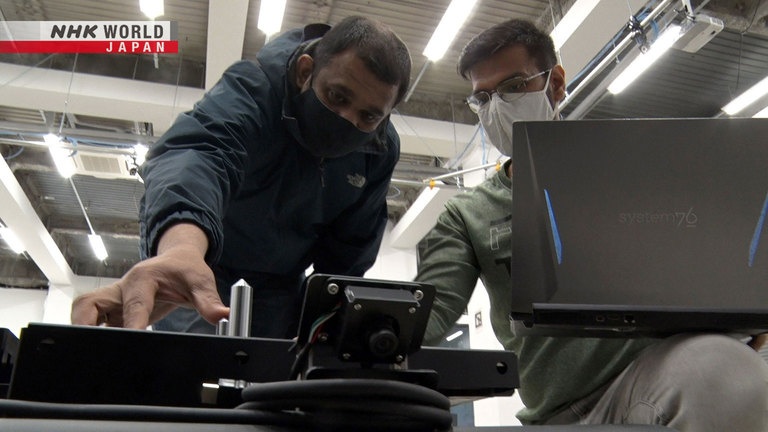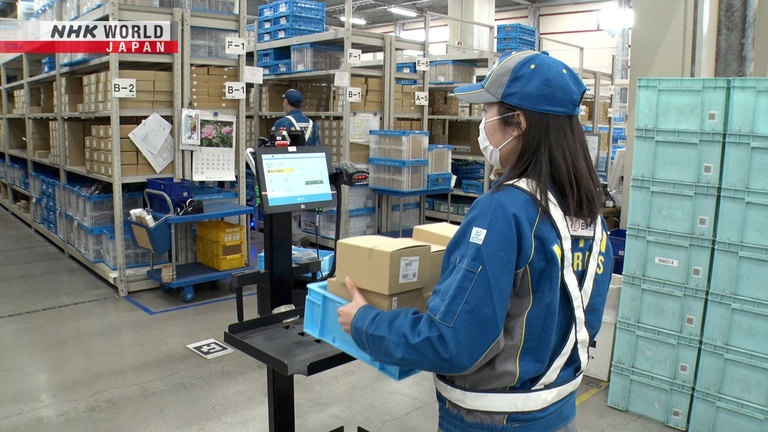Living With Robots in Aging Countries: Gajan Mohanarajah / Robot Engineer
The logistics industry is suffering from a labor shortage amid the COVID situation. We feature an engineer who has developed a cloud robotic system aiming for collaborating between humans and robots.




Transcript
Direct Talk
The coronavirus pandemic stretches on, and
the number of people shopping online continues to grow.
The logistics sector is suffering from serious labor shortages.
To alleviate the problem,
corporations are introducing...robots.
They zip through narrow aisles in Japan's warehouses.
Gajan Mohanarajah
CEO, Rapyuta Robotics
Sri Lankan Gajan Mohanarajah, a resident of Japan,
envisions a future society where robots play a greater role.
Robots have a lot of applications. It's not just
limited to logistics, although we are starting at logistics.
I don't see a completely automated world.
I see a world where robots and people coexist, helping each other.
Industrialized countries face a continuing decline in population.
Are robots the saviors of society?
Living with Robots in Aging Countries
Ota, Tokyo
A distribution center in Ota, Tokyo.
Products fill the racks.
A common sight in this warehouse...
is an autonomous mobile robot,
or AMR, deftly dodging obstacles.
It uses artificial intelligence to identify and
maneuver the aisles, without collisions.
On arrival at its destination, the robot waits for a worker.
So this robot wants me to pick from this number,
C-5-13-5-5.
The screen displays the product ID,
the amount ordered, and the product's location.
So I look for this number.
So it's C-5-13-5-5.
I pick this item.
I scan it.
And I put it here.
So the robot is telling me to go to C5.
So the robot goes somewhere.
But this robot does not work alone.
The warehouse has 15 robots and 6 human workers –
all move as a team to collect the orders.
Workers once pushed trolleys around to fulfill customer orders,
but the introduction of robots has
more than doubled their productivity.
Once a robot has finished its task,
it automatically returns to its station
and charges as it awaits its next order.
The robots were developed by Sri Lankan Gajan Mohanarajah.
So let me explain a little bit about what this robot has.
The reason we started with the
logistics for automation is because
it's one of the domains that is seeing very less
automation nowadays compared to manufacturing.
A significant portion of the work is being done by people,
and the people have to carry a lot of heavy things.
People have to walk very long distances.
So the general rule of thumb is that
robots should focus on simple, repetitive, boring tasks,
while people should focus on more complex tasks
that require more cognitive skills.
They can actually do a lot of things themselves.
But people also can do some things.
And then how do we connect these, these two different worlds?
I would rather term it as "collaboration" than "control."
One key point was ensuring the robots
work in harmony with the staff.
You can see the sensors over here.
So the one in the bottom tells you where the robot is.
And this sensor tells you like
in 3-D what are the obstacles.
Especially very narrow Japanese warehouses.
The sensors were developed
to suit the conditions in Japanese warehouses,
where many workers and obstacles are present.
When two robots detect a possible collision,
one will move to the side.
Even in congested areas, the robots cooperate
so as not to hinder the movement of the staff.
Aisle sizes are relatively small,
so we have about 90-cm aisles and we need to navigate in that.
As you can see this robot now
it's trying to squeeze in between us and go.
So this kind of behavior is very necessary
for Japanese warehouses.
We want to significantly reduce the burden on people
working on this picking operation.
So before the robots they used to walk like 20 km.
We believe we at least like halved the distance
so that like they can focus on more things that create value.
And we are quite happy about this performance here.
One company uses Mohanarajah's robots.
Shindou Katsunori
Nippon Express
Before we introduced the robots,
our staff here used to push trolleys around,
and carry around picking lists,
to take the products off the shelves.
Since we started using the AMRs,
the robots, the staff now follow the robots around.
They no longer need to push around carts, and
they don't have to worry about carrying things around.
As a result, the picking is now quicker,
the work time is shorter, and the work load is lighter.
So staff can now knock off earlier, without doing any overtime.
Koto, Tokyo
Today, Mohanarajah continues to develop and improve his robots
with staff drawn from 20 countries around the world.
He was born and raised in Sri Lanka to doctor parents.
I think I was interested in robotics from a very early age.
I think that's coming from in Sri Lanka, like I was focusing
on the maths or engineering stream, even in high school.
Robotics is a domain where all different
other domains come together:
electrical engineering, mechanical engineering,
maths, physics, computer science.
So I loved the fact that when I do robots,
I actually get to touch all these different fields.
Then and when I was graduating my high school
that's when the Asimo was introduced in Japan.
I was very excited to see that.
It's a humanoid robot very smoothly walking around
and interacting with people.
So that got me very excited.
These robots, which are programed to move on two legs,
were released in Japan in 2000.
Hello, everyone.
Thank you for coming today.
The robot surprised the public with its ability
to recognize faces and move in tandem with humans.
Mohanarajah's fascination impelled him to study in Japan.
After graduating from the Tokyo Institute of Technology,
he studied in Switzerland.
But he decided to return to Japan to start his company.
Japan has some great technology
to build very high-quality hardware,
a great technology to build
control systems that controls these hardware
and also the sensor technologies.
Japan has always been a forerunner in
building very small sensors with high resolution.
So those kinds of ecosystems eventually support
and accelerate the whole development process,
and we are very lucky to be in Japan
and also get the support of all these players
who come together to build the robotic solutions.
In addition to the technology that is available to build robotics,
the business manner or the integrity
that people have when it comes to the quality,
when it comes to the delivery date is... we really appreciate it.
It's a very high bar they have set to themselves,
so it's in even in that matter it's a great place to work
and interact and collaborate to build robots here in Japan.
Moreover, Mohanarajah had a strong supporter in Japan
who encouraged him in his venture.
Arudchelvan Krishnamoorthy is a childhood friend from Sri Lanka.
He also studied in Japan, and they shared an apartment.
Upon graduation, Krishnamoorthy
went on to work in the finance industry.
But when he saw the revolutionary,
independently motored robot
that Mohanarajah had made during his studies in Switzerland,
it was a life-changing moment.
He felt stimulated to find ways to put this technology to good use.
That really inspired me, and I thought, like, you know,
we can really contribute to
using this technology to the society.
Because, you know, this 3D works dull, dirty, dangerous work.
But so we strongly believe
these works should be automated,
or like robots or other machine should be taking over
and humans should be more involved into
more challenging works.
so in that way, we thought the technology is that
something we can truly make a change in the world.
So,that's why we started.
Today, Krishnamoorthy is the company's chief financial officer.
Developing robots is expensive.
But both men's determination has produced
practical, specialized technology.
Their endeavors are now entering a new phase.
Our software focuses on building robotic teams.
How enabling others to build robotic team.
So here we are going to take a simple example
and show you how our software
works together to enable a robotic team.
So the robots have the system has decided
let's use to AMR for long-distance hauls
and let's use the forklifts for short-distance pick and drop.
To see how the robots work together,
focus on the robot forklift in the top left of the screen.
It picks up the red item and transfers it to another robot,
which will in turn convey it to another forklift
that is waiting on the right side of the screen.
In this way, one computer controls
the movement of multiple robots
via Mohanarajah's proprietary,
cloud-based operating system,
regardless of the robots' brand or manufacturer.
Robots have a lot of applications.
It's not just limited to logistics,
although we are starting at logistics.
So even the team of "material handling,"
that means moving things from one places to the other,
has applications in manufacturing and construction.
So we do have a few places running on these two domains,
so we can definitely do that.
But on top of that, like,
the machines can do a lot of hard work
that people are hard and repetitive, boring things.
I see a world where robots and people coexist,
helping each other.
The robots' ability to work in teams
brings benefits beyond the logistics sector.
Mohanarajah envisions systems where humans and multiple
robots work together on dangerous construction sites
and in other industries, such as nursing care,
where considerable strength is required.
When robots are actually doing the hard work,
the physical or the repetitive work,
there it opens up a new opportunity
for people elderly to contribute.
One of the challenges of robotics
is they cannot handle all different cases.
So let's say a robot faces
an exceptional scenario that it didn't predict.
And then, the robot has to understand it's confused or lost.
And then it asks for human help.
And here someone remotely, thanks to all the
new 5G technologies where you can transfer a lot of data.
So a person can come and help the confused robot.
So here the great thing is this person
can be someone who is very elderly
can be someone who is physically challenged,
and they also can contribute to
this whole ecosystem of automation.
We definitely envision a world where we people and robot
collaborate together to achieve common objectives.
What is Gajan Mohanarajah's motto?
"To leave the world a bit better."
We as human beings,
we take a lot from environment to sustain our living.
And a lot of people help us to...
starting from a great education.
So I definitely want to contribute back to make a positive sum.
My way of doing that is
building these robots, especially robot teams,
to enable and empower people
so that people can focus on more constructive, creative things.
"To leave the world a bit better."